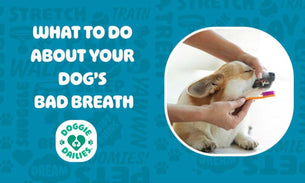Dogs shouldn't have bad breath. If your canine friend is healthy and eating the right things, there should be little or no odor. While doggy halitosis can be a sign of an underlying health issue, it's usually a result of poor dental hygiene.
The good news is that, in most cases, the solutions are simple. But if you're going to take the best course of action for your dog, you need to know about the possible causes of their bad breath.
The Main Causes of Bad Breath in Dogs
While there are many potential causes of your dog's bad breath, here are a few of the most likely:
Teething
When a puppy is teething, food (and bacteria) can collect along the gumline. This causes bad breath, but the problem usually disappears over time.
A gastrointestinal problem
While rare, a potentially serious problem in the stomach, gut or esophagus may be to blame for your dog's bad breath.
Gum disease
A range of diseases that affect the gums and mouth can be the cause of bad breath in dogs. On ailment that may be to blame is stomatitis -- inflammation of the gums and oral tissues. Other diseases that may be causing the problem include growths and gingival hyperplasia (overgrown gums).
Periodontal disease
A large percentage of dogs suffer from periodontal disease during their lifetime. This painful condition is caused by the build-up of plaque and bacteria.
What to Do if Your Dog's Breath is Bad
The simplest way to prevent or eradicate your dog's bad breath is to brush their teeth at least once a week. It's always best to start brushing from day one. This gets the dog used to the procedure over time.
Brush Your Dog's Teeth Regularly
Do not use human toothpaste -- it can be harmful to dogs. Go to your local pet store, and ask for a toothpaste specifically formulated for dogs. You will also need a special toothbrush with a long handle and soft bristles.
Start by giving your dog a little taste of the toothpaste. Lift the upper lip gently, and brush your dog's teeth and gums gently -- in the same way you brush your own. Once you've cleaned every upper tooth, move to the lower set. And be sure to reach the molars at the back of the mouth.
Your dog may hate this process at first. However, you should persist with it as often as possible. At the end of every clean, reward your dog with a tooth-friendly treat.
Give Your Dog Healthy Treats
Ask your vet or local pet store owner about treats that aid good dental hygiene. Some of the products available today actually help to minimize plaque, tartar and bacteria accumulations. Use these treats to reward good behavior -- which should include sitting still for teeth-brushing sessions.
Ask Your Vet About Supplements and Additives
There are a few food supplements and water additives that can improve dental hygiene over time. The great thing about these products is that they can be hidden, and don't involve wrestling your dog to a standstill.
If the Problem Persists, Speak to Your Vet
Try the steps listed above for a week or two. If your dog's bad breath persists -- or it's accompanied by other symptoms -- speak to your vet as soon as possible. A vet will examine your dog, check its mouth and ask you about the dental hygiene steps you take at home. It may be necessary to take a biopsy from the dog's mouth to rule out more serious problems.
If your dog has bad breath, don't ignore the problem. It could be a sign of a serious health problem.








